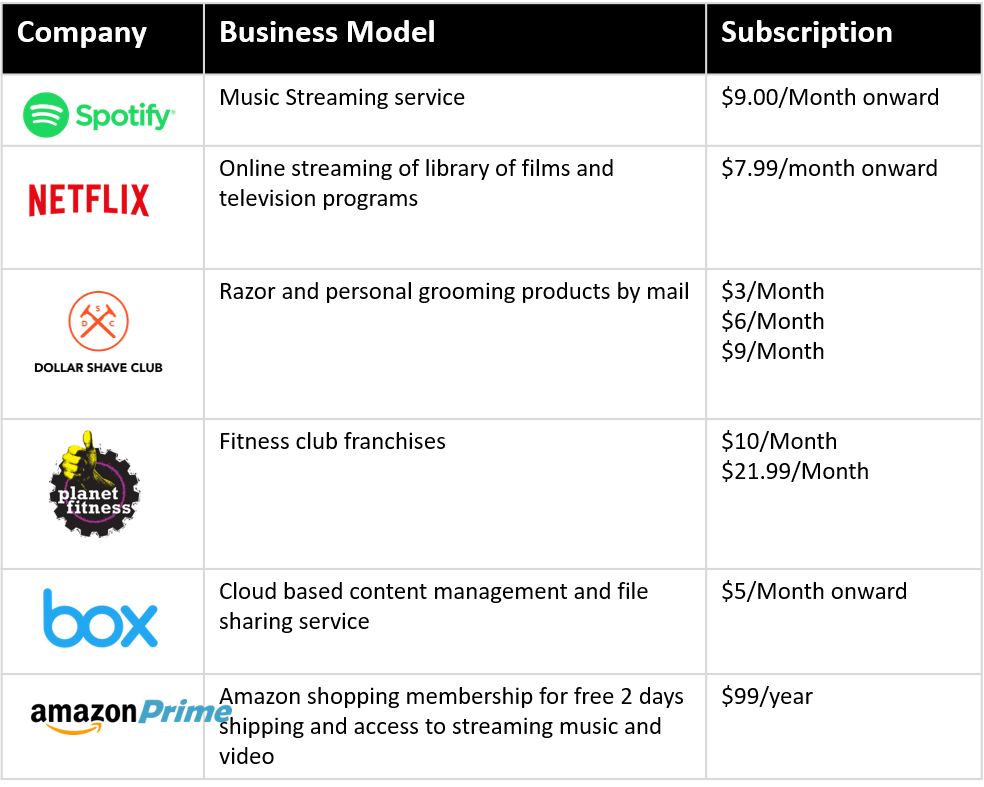The financial crises of 2008 is considered by most economist as the worst financial crises, since the Great Depression of the 1930s. Undoubtedly, it was the worst period, but if one looks at it from a positive angle, it could also be termed as the year of Digital Transformation journey. On one side, we had the great recession that had a very negative impact on – business investment, investor sentiments, consumer spending and not to forget the individual income. On the other side, we saw the rising technology innovations which led to the new business model. Even in this worst environment, few innovative – engineers, economist and entrepreneurs had a hope that the consumers are willing to spend but, their spending behaviors could be persuaded to change. This gave rise to a Subscription based business model.
“Subscription business model is a business model where a customer must pay a subscription price to have access to the product and services. The model was pioneered by magazines and newspapers but is now used by many businesses and websites.”
Reference – https://en.wikipedia.org/wiki/Subscription_business_model
Where we stand currently?
As we accelerate into the digital transformation journey, the subscription-based business model seems to be the most viable option. This model has a win-win situation for both the service/product provider and the consumer. Over the past few years, we have seen the rise of Unicorns (start-up company valued at more than billion dollars). Most of them have embraced subscription business model as the DNA for offering the product/services to the consumer. The success of the subscription model in music, video, and movie/TV streaming to Software-as-a-service are some of the good examples of main-steam populations shift in buyer’s preference.
Take for example the music industry – we earlier had to buy a full music album in the form of cassette and/or CD. This created a two-fold problem –
- We spend the money on buying the full music album; even though we might like only 2-3 songs in it.
- It also gave rise to the music piracy whereby individual songs could be downloaded for free.
The subscription model by Spotify and Pandora have revolutionized the music industry. The subscriber of these services pays a monthly small subscription fee and have access to whole lots of music on demand. In turn, is resolve both the issue listed – Paying for ownership of music album and songs piracy. If one has access to all the latest and greatest songs on demand why would some on opt to download a pirated song?
Examples of Successful Subscription-based businesses:

Advantages of Subscription-based business model
| Advantages for Customer | Advantages for Business |
|
|
Types of Subscription Model
Primarily, the subscription-based business model can be explained in two different ways. Although both derive the same meaning, it is just a way to look at the same business model from two different angles.
By Subscription Prices
Let’s review the subscription model categories by the price the customer pays for the good and services. The price of the subscription is the key components and provides the most customizable options available for the business units to offer it to their prospective client.
| Subscription Type | Description | Companies |
| Fixed Price/ Fixed Service | The subscriber pays one set predetermined price for a given period to avail the service. |  |
| Fixed Price/ Unlimited Service | The subscriber pays a one set of fixed price and intern they can have unlimited access to the product/services |  |
| Pay-as-you-go | As the name suggests, the subscriber pays only for the usage of the product/services. |  |
| Premium | The subscriber pays a monthly basic fee to avail the product/services and is usually charged extra fees for additional services. |   |
| Freemium | The service provider offers their most of the service for free of charge but in exchanges of user information (mostly). Sometimes they do charge extra for additional services. |  |
By Product/Service Offering
Here the subscription model is categorized by the way the product/services are offered to the customer.
| Subscription Type | Description | Companies |
| Replenishment | Replenishment-based subscription model is often used for everyday usage product for which the subscriber can rely on the product, brand, content, etc. The model has taken the monthly recurring purchases of product and packaged into an elegant and interesting way. |   |
| Discovery | Discovery model takes the replenishment model step ahead by packaging the product as a surprise gift. Subscription to this service is like personalized shopper surprising them every time with new goods, products, and packaging. Subscribers are often encouraged to share the video of opening the package on social networking site. |   |
| Productivity/Usage-Based | This model allows the subscriber for the use of good/services in exchange for monthly low recurring fees. Traditionally, the user had to pay a huge lump-sum amount to buy a product/services. But with the evolution of cloud technology, most software business has moved to a subscription model whereby the user pays a monthly/yearly recurring fee for use of the software. |   |
Conclusion
The rise and rise of the subscription business model is the testimony of the changing customer behavior and the way a customer wants to do business transactions. The Millennial generations are generally considered to be the driving force of adopting the new technology/innovation and other generations simply start following them. Today Millennials generations find a subscription model to be very simple, flexible, and affordable without having to commit to longer-term purchasing.
Traditionally, the business transaction follows the cycle of Marketing – Sales – Marketing. After every cycle of marketing-sales, the new cycle of marketing-sales starts all over again to convince the customer to buy again. Thus, instead of providing the best product/services to the customer, business spend a good amount of time on promoting the product/services. This a very costly and time-consuming process for both the business unit and the customer.
The DNA of the subscription business model is customer retention. Once the customer subscribes- then the business simple job is to provide the best product/services consistently so that customer does no leaves them. This is a win-win situation for both the customer and the business. Subscription-based business model is here to stay and companies need to find a way to adopt it.
